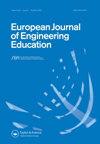调查一年级工程专业学生的工程身份发展和稳定性:以人为本的方法
IF 2.8
Q2 EDUCATION & EDUCATIONAL RESEARCH
引用次数: 0
摘要
工程身份在工程中是一个快速发展的结构,主要是由于它与工程持久性的联系。然而,大多数工程身份研究本质上是定性的,或者将分析技术中的个体描述为来自单一种群。本研究首次允许使用随机截距潜在转移分析的新技术检测不同有意义的工程学生群体,展示在结构上的相似性。通过本研究,我们确定了本科一年级学生中三个稳定的工程身份类别。随着时间的推移,女性比男性更有可能晋升到更高的工程身份阶层。不幸的是,COVID-19的影响对一些学生产生了消极的工程身份发展模式。最后,对学生第一年的工程身份类作业与他们选择/不选择工程专业的关系的描述性分析表明,大学入学时的微积分准备可能是这些关系的重要组成部分。本文章由计算机程序翻译,如有差异,请以英文原文为准。
Investigating engineering identity development and stability amongst first-year engineering students: a person-centred approach
Engineering identity is a rapidly evolving construct within engineering, primarily due to its link to engineering persistence. Yet, most engineering identity research has been qualitative in nature or has described individuals within the analytical technique as coming from a single population. This study is the first to allow for the detection of different meaningful groups of engineering students demonstrating similarity on the construct using the new technique of Random Intercept Latent Transition Analysis. Through this study we identified three stable classes of engineering identity amongst first-year undergraduate students. Women demonstrated a greater likelihood of advancing to higher engineering identity classes over time than men. Unfortunately, the influence of COVID-19 yielded negative engineering identity developmental patterns for some students. Lastly, descriptive analyses of students’ first-year engineering identity class assignments in relation to their selection/non-selection of engineering majors revealed Calculus-readiness upon college entrance might be an important component in these relationships.
求助全文
通过发布文献求助,成功后即可免费获取论文全文。
去求助
来源期刊

European Journal of Engineering Education
EDUCATION & EDUCATIONAL RESEARCH-
CiteScore
7.30
自引率
13.00%
发文量
64
期刊介绍:
European Journal of Engineering Education is published six times a year in print and electronic editions and provides an essential forum for dialogue between researchers and specialists in the field of engineering education, at European and worldwide levels. European Journal of Engineering Education is the Official Journal of SEFI, the Socièté Européenne pour la Formation des Ingénieurs (the European Society for Engineering Education). SEFI is a non-governmental organization whose aims are to develop information about engineering education, to improve communication and exchange between professors, researchers and students and to promote cooperation between the various institutions concerned with engineering education.
 求助内容:
求助内容: 应助结果提醒方式:
应助结果提醒方式:


